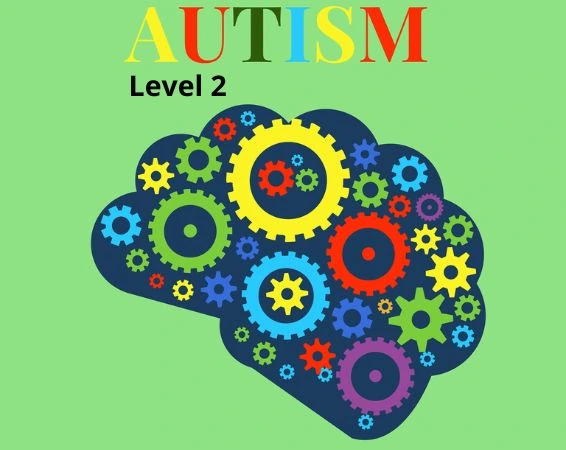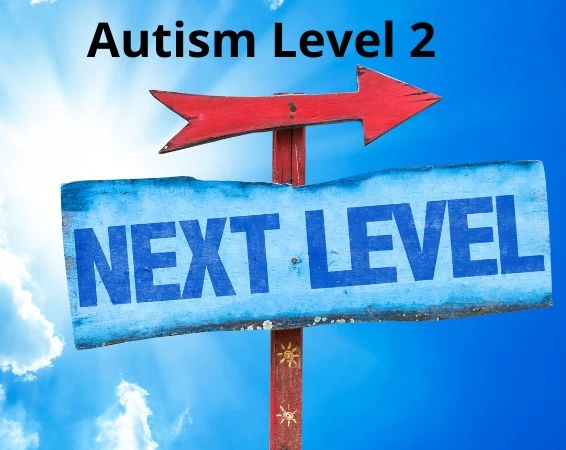Did you know about 31% of people with autism have Level 2 symptoms? They need a lot of support. This percentage with Level 2 autism shows the importance of understanding these symptoms and their impact on society.
Level 2 autism is a big part of the autism spectrum, marked by clear communication problems and limited behaviors. Looking into these numbers helps us see how autism affects people, families, and communities in the U.S.
Learning about Level 2 autism symptoms is key to creating better support systems. It helps in making educational plans and care strategies that fit each person’s needs. Each statistic tells a story of a person with unique experiences and possibilities for growth.
Table of Contents
Key Takeaways
- Level 2 autism affects about 31% of autism spectrum cases
- Needs a lot of support and special help
- Communication problems are key signs
- Finding autism early can greatly improve outcomes
- Custom plans are essential for managing symptoms
Understanding Level 2 Autism: Definition and Key Characteristics
Autism spectrum disorder (ASD) is a complex condition with different levels of severity. Level 2 autism is a moderate stage, marked by big challenges in social communication and behavior. It’s important for parents, teachers, and doctors to understand these symptoms.
People with level 2 autism face bigger hurdles than those with level 1. They need a lot of help to get through the day.
Core Features of Level 2 Autism
- Limited verbal and nonverbal communication skills
- Restricted social interaction capabilities
- Highly specific behavioral patterns and intense focus on specific interests
- Pronounced sensory sensitivities
- Difficulty adapting to changes in routine
Distinguishing Level 2 from Other Autism Levels
Level 2 autism symptoms are quite different from other levels. It’s not as easy as level 1, which needs little support, or as hard as level 3, which needs a lot. Level 2 is in the middle, with its own set of challenges.
| Characteristic | Level 1 Autism | Level 2 Autism | Level 3 Autism |
|---|---|---|---|
| Communication | Minor challenges | Significant difficulties | Severe communication impairment |
| Social Interaction | Limited struggles | Moderate social barriers | Extreme social isolation |
| Support Needs | Minimal | Substantial | Very extensive |
Impact on Daily Functioning
Autism level 2 symptoms greatly affect daily life. They often find it hard to:
- Keep up social relationships
- Adjust to new places
- Handle too much sensory input
- Share complex feelings
Early help and special support can really help those with level 2 autism.
Percentage with Level 2 Autism: Current Global Statistics
To grasp the prevalence of level 2 autism in adults, we must look at global research and trends. Recent studies offer key insights into how many people have this autism spectrum disorder.
Worldwide, about 1-2% of adults have level 2 autism. The rates differ by region and group. Researchers have found some patterns:
- Males are diagnosed more often than females
- Urban areas have higher rates than rural ones
- Worldwide, diagnosing autism is getting better
Tracking level 2 autism in adults is hard. But, thanks to better diagnostic tools, we can spot it more accurately. Cultural differences and healthcare access affect how many are reported.
Looking at different places shows interesting differences:
- United States: About 1.5% of adults
- European Union: Around 1.3% of adults
- Asia-Pacific Region: Estimated 0.9% of adults
As we learn more about autism, we’re getting a clearer picture of level 2 autism. Future research will likely give us even more detailed information.
Diagnostic Criteria and Assessment Methods for Level 2 Autism
To understand Level 2 autism, we need a detailed approach. This involves many professionals and special tools. We look at how a person develops and what they can do.
Experts follow a detailed process to see if someone can move from Level 3 to Level 2 autism. This process is complex and needs many healthcare experts.
Professional Evaluation Process
A thorough autism assessment includes:
- Looking at a person’s developmental history
- Watching their behavior closely
- Talking to parents, caregivers, and teachers
- Using standard tests for development
Common Assessment Tools
Doctors use certain tools to check autism levels:
- Autism Diagnostic Observation Schedule (ADOS)
- Childhood Autism Rating Scale (CARS)
- Autism Diagnostic Interview-Revised (ADI-R)
Age-specific Diagnostic Considerations
How we diagnose autism changes with age. Young children are checked on developmental steps. Adults are looked at for how well they adapt and communicate.
Getting the right diagnosis is key for support and plans.
Each test looks at different parts of a person’s abilities. This gives clues on if autism levels can change.
Level 2 Autism in Adults: Prevalence and Challenges
Living with level 2 autism in adults brings special challenges. Adults with this level need a lot of help to get through daily tasks. Their autism affects how they interact with others, communicate, and live independently.
Some big challenges for adults with level 2 autism include:
- Struggling to keep a job
- Having trouble with social communication
- Needing a lot of support in daily life
- Dealing with complex emotions
About 15-20% of adults with autism have level 2. They face many hurdles, such as:
- Building close relationships
- Adjusting to work settings
- Handling sensory issues
- Living on their own
Getting professional help is key for adults with level 2 autism to improve their lives. They can benefit from vocational training, therapy, and social skills programs. These help them learn important life skills.
Many adults find out they have autism later in life. This shows the need for ongoing checks and support plans that fit each person’s needs.
Support Requirements and Intervention Strategies
People with level 2 autism need a lot of support to face daily challenges. The right help can greatly improve their life and help them live on their own.
Creating good support plans is complex. It involves many areas of a person’s life. Every person with level 2 autism is different, so their support must be tailored to them.
Educational Support Systems
Special education is key for those with level 2 autism. These programs focus on:
- Personal learning plans
- Structured classrooms
- Learning social skills
- Adaptive learning methods
Therapeutic Interventions
Therapy helps people with level 2 autism learn important life skills. Important therapies include:
- Speech and language therapy
- Occupational therapy
- Cognitive behavioral therapy
- Sensory integration therapy
“The right support can transform challenges into opportunities for growth and independence.” – Autism Research Institute
Family Support Resources
Families are very important in supporting those with level 2 autism. There are many resources available, such as:
- Respite care services
- Support groups
- Parent training workshops
- Online counseling platforms
Even with challenges, many with level 2 autism can live independently. The secret is to use personalized plans that focus on their strengths and needs.
Can Level 2 Autism Progress to Different Levels?

It’s important for families and individuals with autism to know about level progression. While autism levels can change, it usually happens with the right support and strategies.
Studies show that people with level 2 autism can get better. The key factors include:
- Early intervention quality
- Individualized therapeutic approaches
- Personal developmental capacity
- Consistent behavioral support
When looking at if level 3 autism can move to level 2, experts say each person is different. Some see big improvements with therapy, while others stay about the same.
| Autism Level | Progression Possible | Key Intervention Strategies |
|---|---|---|
| Level 3 | Moderate to High | Intensive behavioral therapy |
| Level 2 | Moderate | Targeted social skills training |
| Level 1 | Lower | Supportive counseling |
Neuroplasticity is key for improvement. Your dedication to support and tailored interventions can greatly help those with autism.
“Progress is not about achieving perfection, but about continuous personal growth and understanding.” – Dr. Rebecca Thompson, Autism Research Institute
While moving between autism levels is possible, the main goal is to support each person’s strengths and improve their life quality.
Independent Living Possibilities with Level 2 Autism
It’s important to know if people with level 2 autism can live on their own. This question affects families and individuals dealing with autism. The answer depends on the person’s abilities, support, and the help they get.
To live alone with level 2 autism, you need a good plan and a strong support network. Some people can live partly or fully on their own with the right help and skills.
Residential Housing Pathways
- Supported living apartments
- Group home environments
- Semi-independent residential programs
- Family-assisted living arrangements
Critical Support Services
Special help is key for those with level 2 autism to learn life skills. These services include:
- Daily living skill training
- Employment coaching
- Social integration programs
- Personal management guidance
Success Stories of Independence
There are many examples of people with level 2 autism living independently. They learn to handle sensory issues, talk to others, and interact socially.
| Independence Level | Support Intensity | Key Skills Developed |
|---|---|---|
| Minimal Support | Low | Personal hygiene, basic cooking |
| Moderate Support | Medium | Financial management, transportation navigation |
| Comprehensive Support | High | Employment maintenance, apartment living |
Every person’s journey to independence is different. They need a plan made just for them and to keep learning new skills.
Early Detection and Its Impact on Outcomes

Spotting autism level 2 symptoms early can change a child’s life. It gives families and doctors a chance to start early help. This help is key for growing social and thinking skills.
Autism level 2 symptoms often show up between 2-3 years old. They include special behaviors like:
- Limited verbal communication skills
- Significant challenges with social interactions
- Restricted repetitive behaviors
- Difficulty adapting to environmental changes
Experts say we should screen for these signs early. Early help can teach kids important skills for talking and adapting.
| Age Range | Detection Indicators | Potential Intervention Outcomes |
|---|---|---|
| 18-24 Months | Minimal eye contact | Enhanced social engagement |
| 2-3 Years | Limited language development | Improved communication skills |
| 3-4 Years | Repetitive behavior patterns | Better adaptive functioning |
Being proactive can greatly help your child’s future. Talking to pediatricians and developmental psychologists is a good first step. They can give a detailed check for autism level 2 symptoms.
“Early detection is not a limitation, but a pathway to understanding and supporting unique developmental journeys.” – Dr. Rebecca Martin, Child Neurodevelopmental Specialist
By catching autism level 2 symptoms early, families can get the right support. This support helps grow a child’s strengths and possibilities.
Geographic Distribution and Demographic Patterns
Looking into how level 2 autism in adults spreads across the U.S. gives us important clues. It shows how this condition affects different areas and groups of people.
Studies show big differences in how common level 2 autism is in different states. Some places have more cases, linked to several important factors:
- Access to specialized diagnostic services
- Healthcare infrastructure
- Cultural awareness of autism spectrum disorders
- Urban versus rural population densities
When it comes to adults with level 2 autism, some trends stand out. Men are more likely to be diagnosed, with about 4 men for every 1 woman. Also, where someone lives and their economic status can affect if they get help.
Regional variations suggest that having good diagnostic methods and support is key to dealing with level 2 autism in adults.
States like California, Massachusetts, and New York often see more autism cases. These places usually have better healthcare and more knowledge about brain disorders.
New studies are looking into how where you live, who you are, and getting a diagnosis for level 2 autism in adults all connect.
Conclusion
Understanding Level 2 autism means seeing the special challenges and strengths people face. It might seem hard to handle, but studies show many can live on their own with the right help. This help includes support and special strategies.
Learning about Level 2 autism opens up new insights into neurodiversity. Early detection and targeted help are key. They help people develop important life skills. With the right approach, living independently is within reach.
Changing how society views neurodiversity is key. By accepting neurodiversity, we help people with Level 2 autism use their unique talents. Programs, therapies, and community support can make a big difference.
As research grows, our support for neurodivergent people is more important than ever. Your efforts to raise awareness and support can help create a more inclusive world. This world values and celebrates the diverse ways people experience life.
Discover our post: Exploring the Brain in Autism: Brain Development and Behavior
FAQ
What are the primary symptoms of Level 2 Autism?
Can someone with Level 2 Autism live independently?
How do Level 2 Autism symptoms manifest in adults?
Is it possible to improve from Level 3 to Level 2 Autism?
What support services are most critical for Level 2 Autism?
How early can Level 2 Autism be diagnosed?
What educational strategies work best for individuals with Level 2 Autism?

